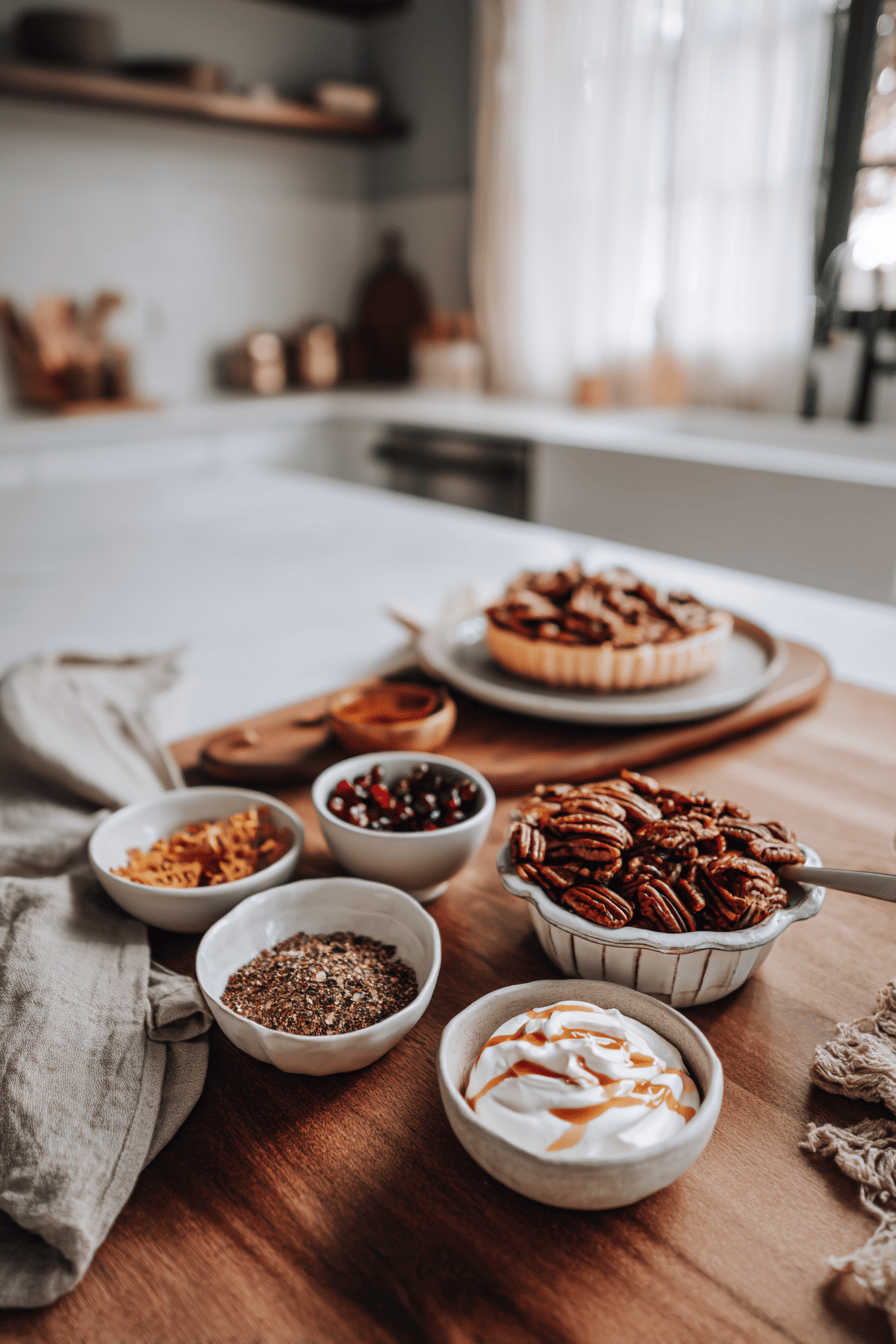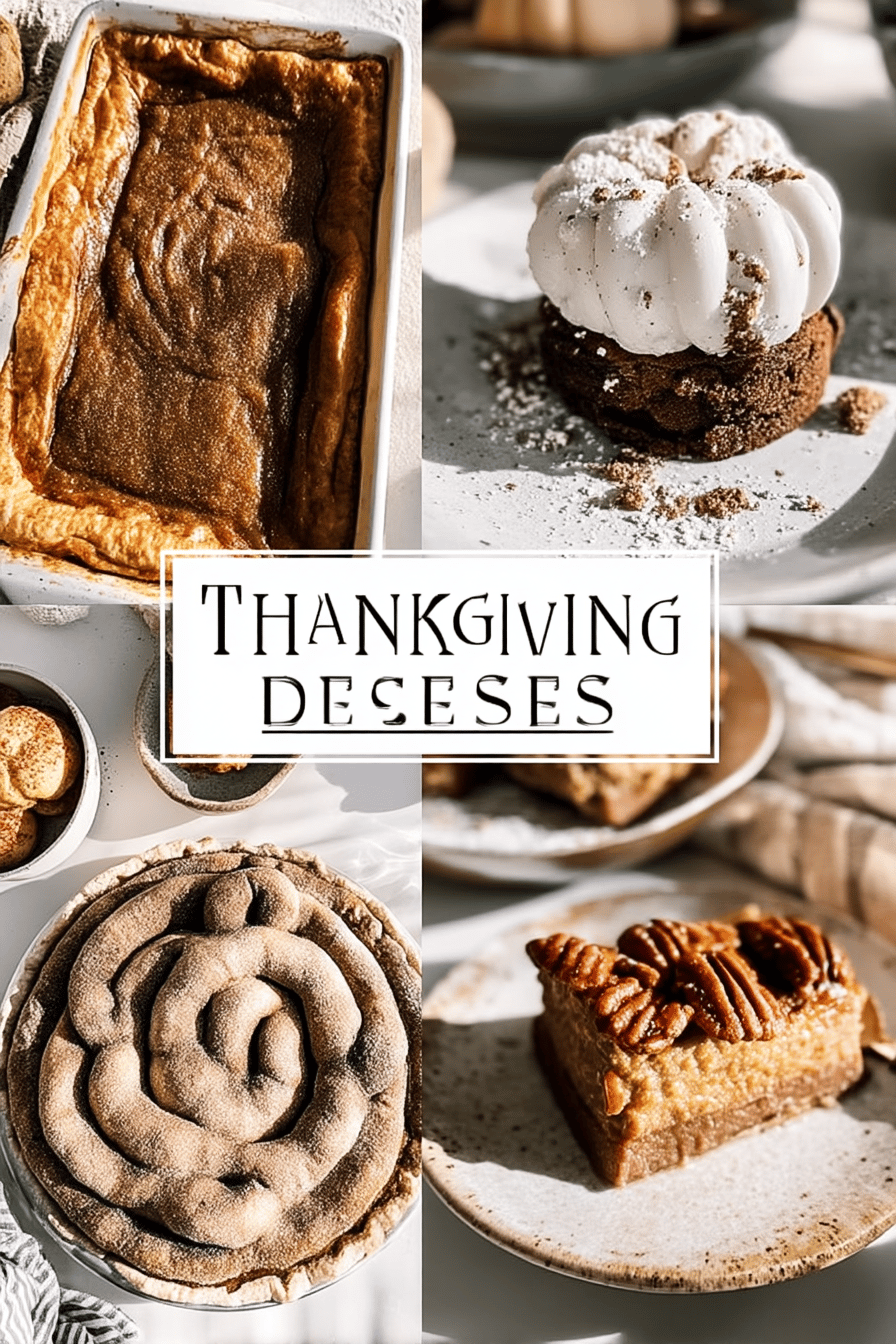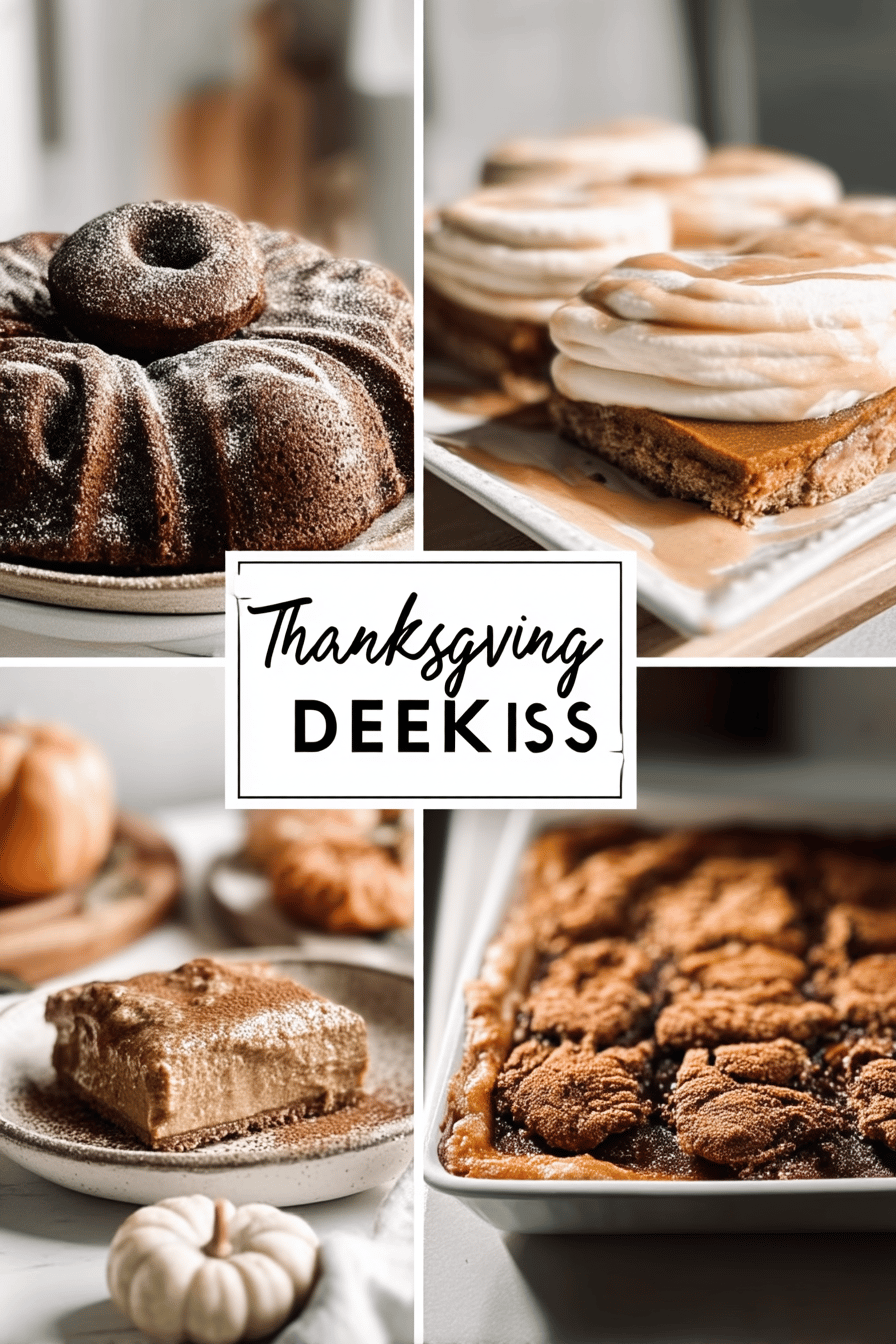Benefits and Advantages of thanksgiving desserts
Thanksgiving desserts provide a satisfying and festive end to your holiday meal, capturing the warmth and spirit of the season. Their simplicity in preparation makes them approachable for cooks of all levels, often using familiar, readily available ingredients that reduce kitchen stress during busy holiday schedules. Many traditional and modern recipes emphasize nutrient-rich, seasonal produce such as pumpkins, sweet potatoes, cranberries, and nuts, offering added health benefits alongside indulgence.
The unique combination of comforting flavors like cinnamon, nutmeg, and caramel paired with innovative twists ensures these desserts cater to diverse palates and dietary needs. Their versatility allows them to fit both intimate family dinners and larger gatherings such as Friendsgiving, making thanksgiving desserts a central element of holiday celebrations, evoking joy and shared memories.
Essential Ingredients for thanksgiving desserts
- Pumpkin puree or mashed sweet potatoes, providing a moist and nutrient-rich base
- Spices such as cinnamon, nutmeg, ginger, cardamom, and cloves to enhance warmth and aroma
- Brown sugar or natural sweeteners like maple syrup for sweetness and moisture
- Flour (all-purpose or gluten-free alternatives like almond or oat flour) for structure
- Butter or plant-based alternatives to add richness and flavor
- Eggs or egg substitutes such as flaxseed meal for binding
- Nuts including pecans, walnuts, or almonds for texture and nutrients
- Dairy ingredients like cream cheese, sour cream, or whipped cream for creamy texture
- Seasonal fruits such as cranberries, apples, or caramelized apples for fresh elements
These ingredients collectively create the classic taste and texture profiles expected from thanksgiving desserts while allowing flexibility for dietary choices such as vegan or gluten-free options. Thoughtful ingredient selection ensures each dish is flavorful, balanced, and celebratory.

Dietary Substitutions to Customize Your thanksgiving desserts
Customizing thanksgiving desserts to suit various dietary restrictions supports inclusive celebrations. To adapt for gluten-free diets, substitute wheat flour with almond flour, coconut flour, or certified gluten-free baking flour blends. Vegans can replace eggs with flaxseed or chia seed eggs (mixed seeds with water), and choose plant-based milks and vegan butters or oils to maintain moisture and richness without animal products.
For those mindful of sugar intake, natural sweeteners such as stevia, erythritol, agave syrup, or maple syrup offer alternatives that reduce caloric load and glycemic impact. To lower fat content, unsweetened applesauce or mashed bananas can replace butter or oil portions while preserving moisture. Additionally, dairy-free dessert recipes can use coconut cream or plant-based creams to substitute for traditional cream or cream cheese without losing creaminess.
These substitutions help maintain the desired dessert texture and taste, ensuring all guests can enjoy delightful thanksgiving desserts regardless of their dietary requirements.
How to Prepare the Perfect thanksgiving desserts: Step-by-Step Guide
- Preheat the oven to the temperature specified in your chosen recipe to ensure consistent baking.
- Combine dry ingredients such as flour, spices, and sugar in a large bowl. Use gluten-free flours or low-calorie sweeteners as needed for diet-specific adaptations.
- Mix wet ingredients separately, incorporating pumpkin puree, plant-based liquids, eggs, or their substitutes.
- Gently fold wet and dry mixtures together to a smooth, uniform batter. Avoid overmixing to keep desserts tender and moist.
- Pour batter into prepared pans or molds, adjusting portions according to dish type (pie crusts, cakes, bars, or cookies).
- Bake according to recipe timing, checking doneness with toothpicks or texture tests suitable to the dessert.
- Allow desserts to cool completely before slicing or applying frostings and toppings to improve flavor development and presentation.
Following these step-by-step instructions ensures thanksgiving desserts turn out flavorful, moist, and suitable for various dietary needs while allowing creativity and personalization.
For more seasonal sweet treats, explore this delicious Sweet Potato Pie Recipe that pairs perfectly with your Thanksgiving feast.

Advanced Tips and Variations
To bring your Thanksgiving desserts to the next level, consider some simple yet effective tips. Toast spices like cinnamon, nutmeg, and cardamom before mixing to release deeper aromas that elevate the flavors. Adding a touch of citrus zest, such as orange or lemon, can brighten traditional autumnal notes and add freshness to pies or cakes.
For textural contrast, fold in chopped nuts like pecans, walnuts, or almonds. Vegan chocolate chips or dried fruits such as cranberries and apricots add bursts of flavor and color. Experimenting with natural sweeteners like coconut sugar, maple syrup, or date syrup can reduce refined sugar content while adding unique flavor accents.
Try customizing crusts or toppings with gluten-free or vegan alternatives to suit your guests’ needs. Layering desserts like pumpkin slab pie with whipped cream or caramel drizzle can add richness and visual appeal. Inviting family participation during preparation not only makes the process enjoyable but also introduces variations and enhancements tailored to your gathering’s tastes.
How to Store thanksgiving desserts: Best Practices
Proper storage is crucial for preserving the texture and flavor of your Thanksgiving desserts. Most baked goods, such as pies, cakes, and cookies, should be tightly wrapped in plastic wrap or stored in airtight containers in the refrigerator, where they remain fresh for up to five days.
For longer storage, freeze desserts by wrapping them securely in foil and placing them inside freezer-safe bags or containers; this can extend freshness for up to three months. To serve, thaw desserts overnight in the refrigerator. Reheat gently in the oven or microwave to restore softness, if desired. Avoid leaving desserts uncovered to prevent drying out or absorbing odors.
Freezing portions or individual slices is convenient for large celebrations, allowing easy distribution and minimizing waste. Following these storage tips ensures your Thanksgiving desserts stay as delicious and inviting as on the day they were made.
Nutritional Value of thanksgiving desserts
| Nutrient | Estimated Range per Serving |
|---|---|
| Calories | 250-350 kcal |
| Total Fat | 10-15 g |
| Saturated Fat | 5-7 g |
| Carbohydrates | 30-40 g |
| Protein | 2-5 g |
| Dietary Fiber | 2-4 g |
| Sugars | 15-25 g |
Thanksgiving desserts typically provide a balanced mix of carbohydrates and fats, with moderate protein content from eggs, dairy, or nuts. Many recipes emphasize natural ingredients like pumpkin, sweet potatoes, and nuts, contributing dietary fiber, vitamins A and C, and minerals. Adjusting sweeteners and incorporating whole-food ingredients can improve nutritional profiles without sacrificing taste. Mindful portion control helps enjoy indulgent desserts responsibly during holiday celebrations.

FAQs: Frequently Asked Questions About thanksgiving desserts
Print
Thanksgiving Desserts: 100+ Classic and Popular Recipes for Your Holiday Table
- Total Time: 1 hour 15 minutes plus additional time
- Yield: Varies by recipe
- Diet: Varies
Description
🥧 Delight in over 100 classic and creative Thanksgiving desserts, from pies to cookies, celebrating the best of seasonal flavors.
🍏 With easy-to-follow recipes, bring warmth and festivity to your holiday table with desserts everyone will love.
Ingredients
Pumpkin puree
Sweet potatoes
Cranberries
Apples
Nuts
Flour
Sugar
Butter
Eggs
Chocolate
Cinnamon
Ginger
Cardamom
Nutmeg
Cream cheese
Whipped cream
Mashed sweet potatoes (450g for sweet potato pie)
Sugar (150g for sweet potato pie or 200g for pumpkin slab pie)
Large eggs (2 for sweet potato pie, 3 for pumpkin slab pie)
Evaporated milk (120ml for sweet potato pie, 250ml for pumpkin slab pie)
Ground cinnamon
Pie crust
Bourbon whipped cream
Pastry crust
Instructions
1. Choose your dessert recipes from classic pies, cookies, and creative alternatives like molten chocolate crackle pie.
2. Prepare your ingredients: gather fresh and seasonal produce like pumpkin, apple, and nuts alongside pantry staples such as flour, eggs, and spices.
3. Follow individual recipe instructions for mixing, baking, cooling, or chilling, making use of minimal equipment when possible.
4. Incorporate finishing touches like frosting, glazing, or toasting for an added festive flair.
5. Present your desserts attractively, garnished with seasonal toppings like sugared cranberries or whipped cream.
6. Enjoy creating a festive atmosphere with family-friendly baking for a joyful Thanksgiving celebration.
Notes
👨👩👧👦 Invite family members to join in baking to enhance the holiday experience.
🎶 Create a cozy atmosphere with seasonal music and decorations while you bake.
🔄 Substitute ingredients based on availability, dietary preferences, or creativity.
- Prep Time: 30 minutes
- Cooling/Chilling time: 1-2 hours
- Cook Time: 45 minutes
- Category: Dessert
- Method: Baking
- Cuisine: American
Nutrition
- Serving Size: Varies
- Calories: Varies
- Sugar: Varies
- Sodium: Varies
- Fat: Varies
- Saturated Fat: Varies
- Unsaturated Fat: Varies
- Trans Fat: Varies
- Carbohydrates: Varies
- Fiber: Varies
- Protein: Varies
- Cholesterol: Varies
Keywords: Thanksgiving, Desserts, Classic, Holiday

